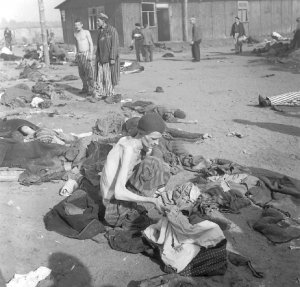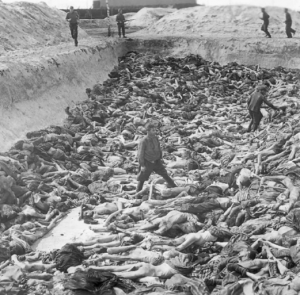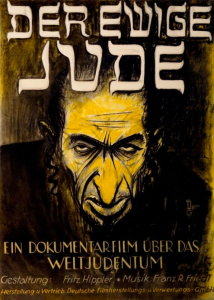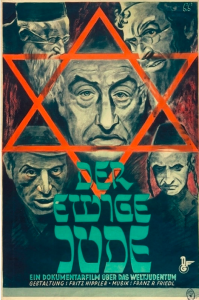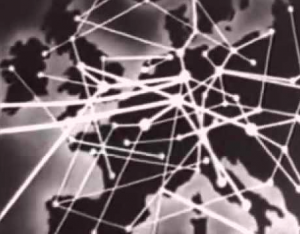by Nona Haller
Topic:
Through film, anti-Semitic ideas were broadcasted during World War II; the emotional effects of this can be analyzed through the films created during World War II.
Introduction:
During World War II, visualization was a main tool to “educate” the general public on anti-Semitic ideals. Films – political propaganda, home videos compilation documentaries, non-fiction, biographies, and autobiographies – develop a solid foundation for understanding the history of anti-Semitic propaganda and the traumatic experiences enforced during the Jewish Genocide. Through the screenings of the Nazi propaganda films, GI documentation, Soviet newsreels, and American made films, our world is able to watch the actions and accusations performed against the Jewish community. Filmmakers were able to use this medium to manipulate anti-Semitic ideals as well as develop new exposition techniques. Cinematic images of the Holocaust have made a crucial impact on educating and bring public awareness of Nazism anti-Semitic actions. Film broadcasted the fenced concentration camps, exposing the horrific tactics used against these Jewish victims. Because of this visual representation, modern society is able to perceive World War II through familiar visual images. The medium of film expanded and popularized anti-Semitism during World War II. The emotional effects of films can be analyzed through the films created during and after World War II.
Books:
Horror in Our Time: Images of the Concentration Camps in the British Media
During WWII, the British public was sheltered from the Jewish death; newsreels and photographic images were hidden from them. This chapter explores how the governments restriction conveyed how the public viewed the anti-Semitic actions of the Nazis and the power of an image. Bergen–Belsen was a specific case of the British Army Film and Photographic Unit (AFPU) took footage of this camp to distribute the knowledge of the horrific Nazi actions against the Jews. An image distills a memory in our minds; seeing the dead bodies on the newsreels toyed with the emotions of the British public, instilling a passion in the community for change.
Caven, Hannah. “Horror in Our Time: Images of the Concentration Camps in the British Media, 1945.” Historical Journal of Film, Radio and Television 21, no. 3 (2003): 205-53.
Holocaust and the Moving Image
This chapter tries to answer the question most filmmakers ask themselves when first creating a Holocaust film: how must the reveal this hirstoric event and efficiently communicate something that actually occurred? Jack Gold discusses the three main approaches that could be taken when creating a filmed based on the Holocaust. This presents the idea that a filmmaker must choose what type of film he would like to create to effectively emotionally touch their audience.
There are many unanswered questions filmmaker face when creating a film representing the Holocaust. A filmmaker must start with this complex question: how must the reveal this hirstoric event and efficiently communicate something that actually occurred? Jack Gold claims there are three basic choices a filmmaker can chose from: (i) using direct evidence, therefor real film, this includes photographs, newsreels, sound recordings, and home movies of the actual events. This is a rather complicated process, but not impossible process, for Holocaust films since during WWII there was a spark in journalistic practices. The second choice a filmmaker can choose from is (ii) Witness accounts. This is when specific accounts, both spectator and participants, record their experiences through either film or voiceover, to allow the audience to understand the happenings of the events. During these accounts, living survivors are able to speak out, explaining historical accounts, adding to the emotional ties of the audience. The process of seeking out these individuals is critical; credibility is the upmost importance of a documentary film.
Haggith, Toby. “Escape From Sobibor: A Film Made for Television Depiciting the Mass Escape from Sobibor Extermination Camp.” In Holocaust and the Moving Image: Representations in Film and Television since 1933, 198-202. London: Wallflower, 2005.
First Films of the Holocaust
This book discusses the idea that during 1940-1950, the West depiction of the Holocaust was based on newsreels filmed during the allied liberation of German; Soviet films were unseen. Although it was Soviet filmmakers who were the first to film the horrors of genocides. This book overlooks the Soviet films and how they were the basis of the public’s awareness of the Nazi’s corrupted practices. Many films were destroyed or have gone “missing” since they were released, causing speculation. This book highlights propaganda tools used to manipulate the public into an anti-Semitic mindset.
This book focuses on the Soviet Newsreels shown in theaters, using live-action Soviet footage to highlight the actions performed in Holocaust. Discusses the implications filmmakers faced, how did society watch and reciprocate this horrific information.
The Soviets changed the “boundaries” of what became acceptable to broadcast to the public.
Hicks, Jeremy. In First Films of the Holocaust: Soviet Cinema and the Genocide of the Jews, 1938-1946, Pittsburgh. Pa: University of Pittsburgh Press, 2012.
Film and Genocide
This book discusses films that highlight the topic of genocide, both fictional and documentary; this covers the Holocaust. Through the medium of the screen, filmmakers have used their voices to discuss the horrific topic: mass genocides. This book explains the techniques different filmmakers used in order to successfully depict the atrocities to the general public. Film and Genocide uses the accounts of three film directors and their films that changed the thoughts of thousands. These films influenced the public’s emotions, shedding light on deeply disturbing, hidden stories, on true accounts.
Watching these films as a spectator: film from a documentation standpoint, watching the holocaust during WWII on screen. How can you remember genocides after the account? This is used through documentary films. Documentary allows there to be a “rewriting” of history by shedding a light on accounts the public is unaware of. This allows the director to bring back the past, showing public actual accounts (real people, events happened to them). Also discuss the impact of films that include “death and witnesses” of the actual people on the audience; this has an emotional success on viewers.
Wilson, Kristi M. Film and Genocide. Madison, Wis.: University of Wisconsin Press, 2012.
Emotional Engineering: Hitler Youth Quex
Goebbels controlled the film industry, giving the Nazi powerful reign over the content produced for both the entertainment and propaganda films. But, the government abused their complete control of the film industry – especially Goebbels. Goebbels roles included: director, top producer, screenplay author and censor, and studio boss, making him the “master of showmanship… the Nazi film minister”. It was Goebbels and Hitler’s combined propaganda techniques that created the anti-Semitic films that influenced the Nazi anti-Semitic practices.
In this book there are quotes of Goebbels translated into english personifying his anti-semitic ideals.
Rentschler, Eric. “Emotional Engineering: Hitler Youth Quex (1933). Cambridge, Mass., Michigan: Harvard University Press, 1996.
“The Demonic Effect”: Veit Harlan’s Use of Jewish Extras in Jud Suss (1940)
Goebbels encouraged Veit Harlan, the director, for main actors to contain pure Aryan blood; this included the Jewish characters, but Harlan ignored these demands. By using Jews, it allowed the qualities the film was representing appear “real” and “truthful”, although they were only stereotypes and false accusations.
This chapter includes english translations of Goebbels explaining his anti-semitic goals and how he uses films to portray them. This chapter also highlights how Goebbels believes Jews should be treated and how they represent the stereotypes that were created against them.
Tegel, Susan. “”The Demonic Effect”: Veit Harlan’s Use of Jewish Extras in Jud Suss (1940).” Holocaust and Genocide Studies, no. 1 – Spring 2000 (2000): 215-41. Accessed December 11, 2015.
“The Image of the Enemy.” In Propaganda and the German Cinema
Film was a critical tool to show these Jewish stereotypes and increase the Nazi Party’s anti-Semitic ideals. Through english translation, Goebbels explains how this film rightfully portrays the Jewish culture and how Germany should take action to exterminate the Jewish community.
Welch, David. “The Image of the Enemy.” In Propaganda and the German Cinema, 1933-1945, 246. Rev. ed. London: I.B. Tauris, 2001.
Images
Horror in Our Time: Images of the Concentration Camps in the British Media, 1945:
One of the main themes of the AFPU was the presence of children in these camps, creating shock amongst the British public and influencing the British Parliament to influence change. This can be seen in these three images.
Caven, Hannah. “Horror in Our Time: Images of the Concentration Camps in the British Media, 1945.” 205-53.
Der Ewige Jude (The Eternal or Wandering Jew)
This film poster for “Der Ewige Jude continues the theme of personifying the Jews in a wicked lens. It highlights the theme of Der ewige Jude: the Jewish community will terrorize the innocent to maintain their wealth and international power.
“Der Ewige Jude (The Eternal or Wandering Jew).” United States Holocaust Memorial Museum. Accessed December 11, 2015. http://www.ushmm.org/information/press/press-kits/traveling-exhibitions/state-of-deception/der-ewige-jude-the-eternal-or-wandering-jew.
“GHDI – Image.”
This is another movie poster that was used to advertise for the film. Not only is the Jewish star the focal point of the poster, but yet again, the Jewish persons appear evil and malicious.
“GHDI – Image.” The Eternal Jew [Der Ewige Jude], Film Poster (September 1940). Accessed November 20, 2015. http://germanhistorydocs.ghi-dc.org/sub_image.cfm?image_id=2331.
Der Ewige Jude “The Eternal Jew”
Der ewige Jude attacked the Jewish community, idealizing the thought of persecuting their race. Goebbels’ film continued to present anti-Semitic messages. The Jews were portrayed to match their stereotypes: foreign, greedy, manipulative, influencers of economics, and performers of ritual slaughters. Through the symbolism of the rat, Der ewige Jude portrayed the Jewish people as uncivilized vermin. During the film there is a scene with fast intercutting from the Jews emigrating worldwide, seen in this image, and a swarm of rats running through sewers.
“Der Ewige Jude “The Eternal Jew”
This movie poster for “Der Ewige Jude” presents a German citizen running away in fear from the two Jewish men on who are overbearing.
“Der Ewige Jude “The Eternal Jew” Www.HolocaustResearchProject.org.” Der Ewige Jude “The Eternal Jew” 2008. Accessed November 11, 2015. http://www.holocaustresearchproject.org/holoprelude/derewigejude.html.
Interviews:
GI Documenting Genocide
During WWII the technology for camcorders started to rise, creating a hype of making “home movies”. Independent filming of WWII amongst the army started to become a common norm. Although it was filmed by amateur cinematographers, this footage was used to highlight the experiences of the Nazi concentration camps, and used for educational purpose. The U.S. Army Signal Corps and the Soviet filmmakers shaped what the general public imagined the genocide to appear as. American soldiers were encouraged to visit the concentration camps and bring cameras for document support. Nazi crimes were filmed, conditions of the jews were broadcasted – seeing the images through the film medium was an acceptable alternative, allowing the public to feel as if they were walking into the camps themselves. Disturbing images were recorded: massive killings, dead bodies. It was though these moving images our cultural memory of the Holocaust and the concentration camps was formed.
This interview follows Joseph Kushlis, a sergeant in the Third Army during WWII, and his memory of retrieving his footage and discusses how his footage influence society’s outlook on the Nazi’s anti-Semitic actions.
Kushlis, Joseph Bernard. Transcript of interview with Dana Kline, Witness to the Holocaust Project at Emory University. March 30, 1979. Box 2, folder 56.
Movies:
Der Ewige Jude “The Eternal Jew”
Der ewige Jude provided graphic images of Jewish ritual sacrifice inflicted upon animals. Trying to repulse the audience, Hippler staged a ritual slaughtering, claiming the Jews were cruel to their animals before consumption. This footage was used to manipulate the audiences’ perceptions of the Jews, making the Jewish community appear savage like. Although this film was created for propaganda for the Nazi state, the film was not a success. It is believed that approximately only one million Germans went to the theaters to see this film; this is a drastic difference from Jud Süß, another Nazi film propagated by Goebbels.
This film was directed by Hipper. He presented this film like a documentary, making the audience watch it with believing eyes. The film contains both documentary and feature footage of Polish ghettoes in September 1939 after the Nazis took control of the town.Although this film presented many inaccurate representations – Charlie Chaplin was portrayed as a Jew, false rituals were personified – it was still shown in theaters.
Der Ewige Jude “The Eternal Jew” Directed by Fritz Hippler. Nazi Germany: Terra, 1940. Film.
Jud Süss
Jud Süß, also known as Jud Süss, was the most successful Nazi propaganda film Goebbel focused on. Based on the historical novel Jud Süss, written by Lion Fechtwagner, Jud Süss is arguable the Third Reich’s most anti-Semitic and controversial films created.Jud Süss stressed the stereotypes of Jews with hooked-noses, power hungry, and how they perform trickery amongst the Christians to steal their riches and children. Süß Oppenheimer, a corrupt Jewish businessman, persuades the Duke of Wuttemburg to give up his riches in return for Oppenheimer’s promise for gaining greater future riches. Throughout the film, Oppenheimer demands become more elaborate, almost causing a civil war; he even convinces the Duke to discontinue the ban of the Jews from Stuttgart. After swindling the Duke from all his wealth, Oppenheimer rapes a wholesome, Aryan, Christian girl as well as torturing her fiancé and father. The film ends with Oppenheimer committing suicide, and all of the Jews are, again, banished from the town.
Goebbels encouraged Veit Harlan, the director, for main actors to contain pure Aryan blood; this included the Jewish characters, but Harlan ignored these demands. By using Jews, it allowed the qualities the film was representing appear “real” and “truthful”, although they were only stereotypes and false accusations.
Jud Süss. Directed by Veit Harlan. Nazi Germany: Terra Film, 1940. Film.
Nazi Concentration Camps
Soviet filmed and released covering the Holocaust that influenced the public, and impacted Western culture. Unlike other films uncovering the anti-Semitic actions of the Nazis, it focused on the sufferings of the Jewish community. It broadcasted actual images of the extermination camps of Aushwitz and Majdanek, cresting emotional ties between the audience and the jewish victims. Although is successfully impacted it’s audience, the film failed to correctly portray the concentration camps: overemphasized the Einstazgruppen killings, and failed to successfully publish the extermination of the jews in the camps. Although it may have lacked historical accuracy, it educated the the importance of the Holocaust and the torturing of the jews during this genocide. This film successfully created an emotional tie between the audience and the victims through extremely physical images of the exterminations. This is an example of how Soviet films were successful in educating the entire world of the Nazi’s actions.
Nazi Concentration Camps. Directed by George Stevens. Germany, 1945. Film.
Newspaper Articles:
Bosley, Crowther, 27 Years a Critic of Films for Times, Is Dead at 75.
Bosley Crowther, a film critic for The New York times from 1940 to 1967, reviewed films worldwide during World War II. Crowther advocated against legislative censorship and encouraged films to portray violence in an historically accurate lens.Bosley highlights the importance of film during World War II. Although the Nazis, Soviets, and British used film to personify different ideas, they used to educate their public. This obituary honors his death and his role in the film industry. He discusses the importance of films during WWII and how it highlighted anti-Semitism.
McFadden, Robert. “Bosley, Crowther, 27 Years a Critic of Films for Times, Is Dead at 75.” New York Times, March 8, 1981, Obituaries sec.
Websites:
Der Ewige Jude “The Eternal Jew”
Anti-Semitic propaganda was an important medium the Nazi Party used to publish their bias, simplistic, ideas. Goebbels used these films as an effective propaganda tool to speak to the general public. Der ewige Jude, also known as The Eternal Jew, was one of the major Nazi films that promoted anti-Semitism. Joseph Goebbels influenced the creation Der ewige Jude and hired Fritz Hipper to direct the Nazi propaganda film. This website includes English translations of Goebbel and the affects this film had on Nazi Germany.
“Der Ewige Jude “The Eternal Jew” Www.HolocaustResearchProject.org.” Der Ewige Jude “The Eternal Jew” 2008. Accessed November 11, 2015. http://www.holocaustresearchproject.org/holoprelude/derewigejude.html.
“Der Ewige Jude (The Eternal or Wandering Jew).”
This article highlight some facts about “Der Ewige Jude” film. From 1940-42, Jud Süss was viewed by over twenty million people, ranked sixth in the box office, and grossed 6.2 million. Watching Jud Süss was mandatory amongst the police and the SS units.
“Der Ewige Jude (The Eternal or Wandering Jew).” United States Holocaust Memorial Museum. Accessed December 11, 2015. http://www.ushmm.org/information/press/press-kits/traveling-exhibitions/state-of-deception/der-ewige-jude-the-eternal-or-wandering-jew.
Jud Suss The Most Successful Anti-Semitic Film Ever Made
Because of the strong emotions Nazi Germany developed in this film, those who were apart of it were punished after the Holocaust. Ferdinand Marian, the star of the film, was banned from continuing his acting career after World War. The success of Jud Süss modeled Veit Harlan into the most important Nazi director. But once the Third Reich collapsed, Harlan was tried from crimes against humanity.
“Jud Suss The Most Successful Anti-Semitic Film Ever Made. Us Www.HolocaustResearchProject.org.” Jud Suss The Most Successful Anti-Semitic Film Ever Made. Accessed November 18, 2015.
Films In Nazi Germany
During World War II, Adolph Hitler and Joseph Goebbels used various techniques to persuade the German public to conform to their anti-Semitic ideas; one of the propaganda techniques the Nazis used was film. World War II brought a proliferation of Nazi propaganda films, manipulating the public’s emotions towards the Jewish community. During the reign of the Nazi Party, Joseph Goebbels was the key communications figure through his extreme power he contained over the film industry. This article includes Joseph Goebbels, the Reich Minister of Propaganda in Nazi German from 1933 to 1945 confession on the purpose of education through films.
N Trueman, C “Films In Nazi Germany” historylearningsite.co.uk. The History Learning Site, 9 Mar 2015. 11 Nov 2015.
